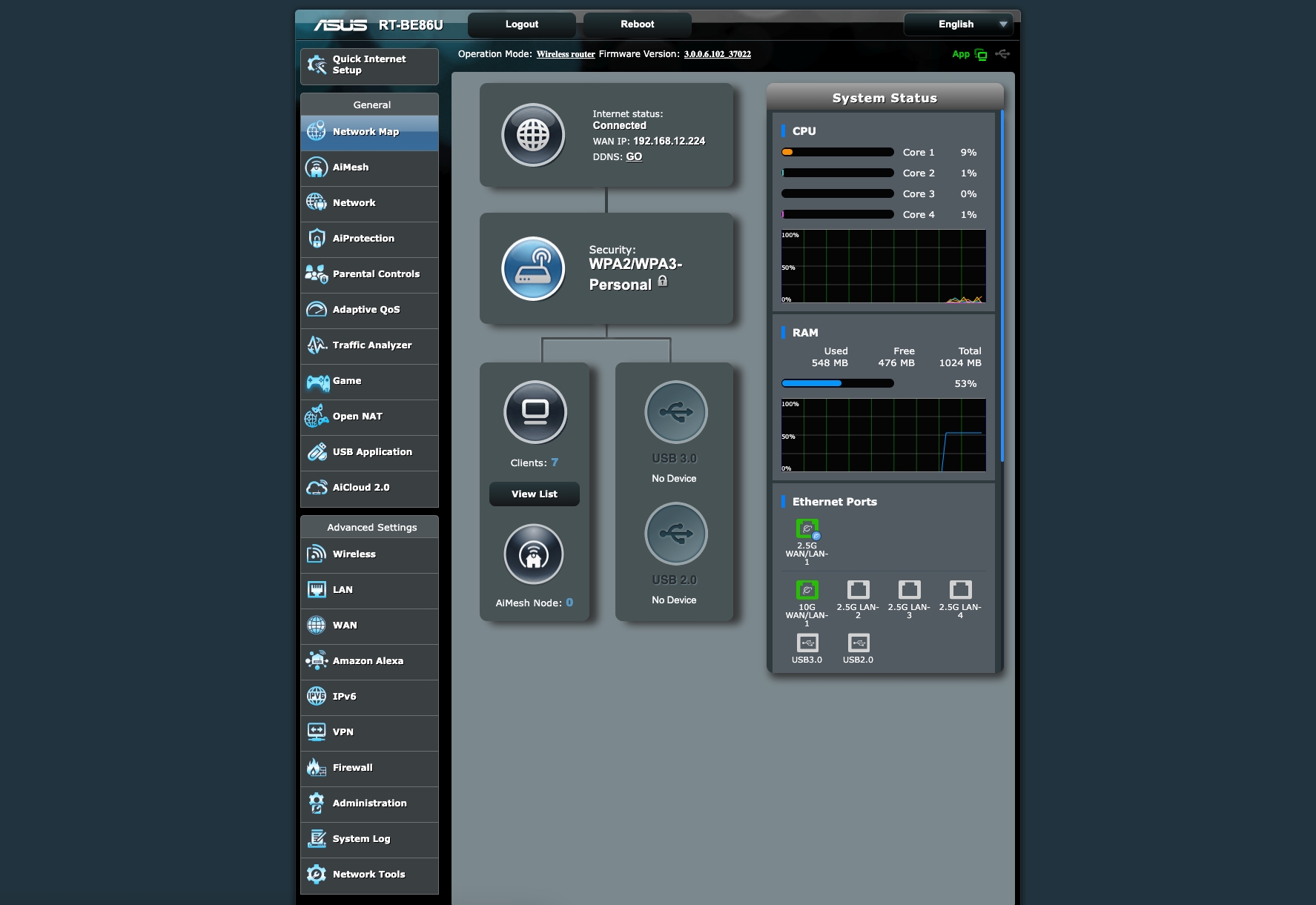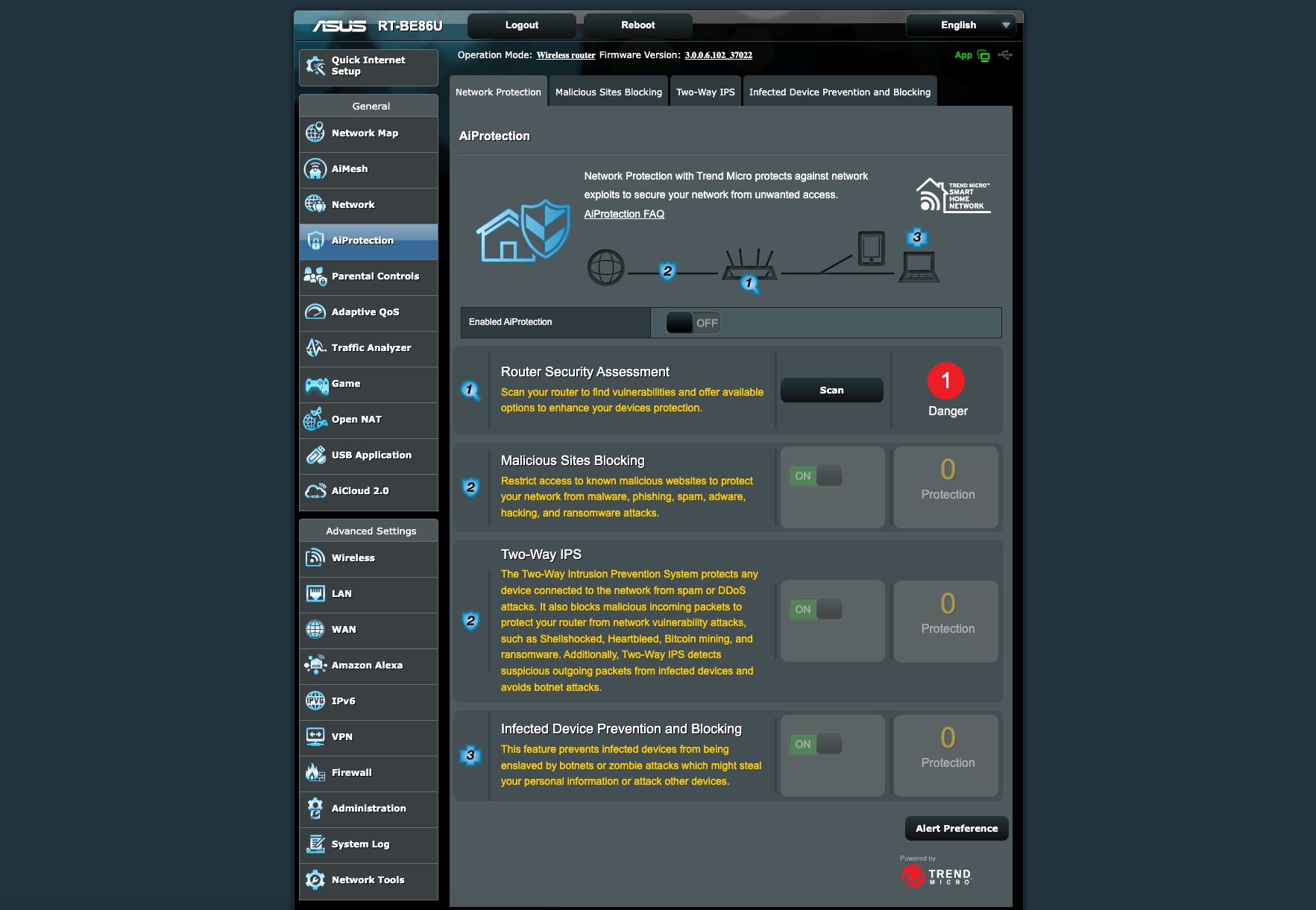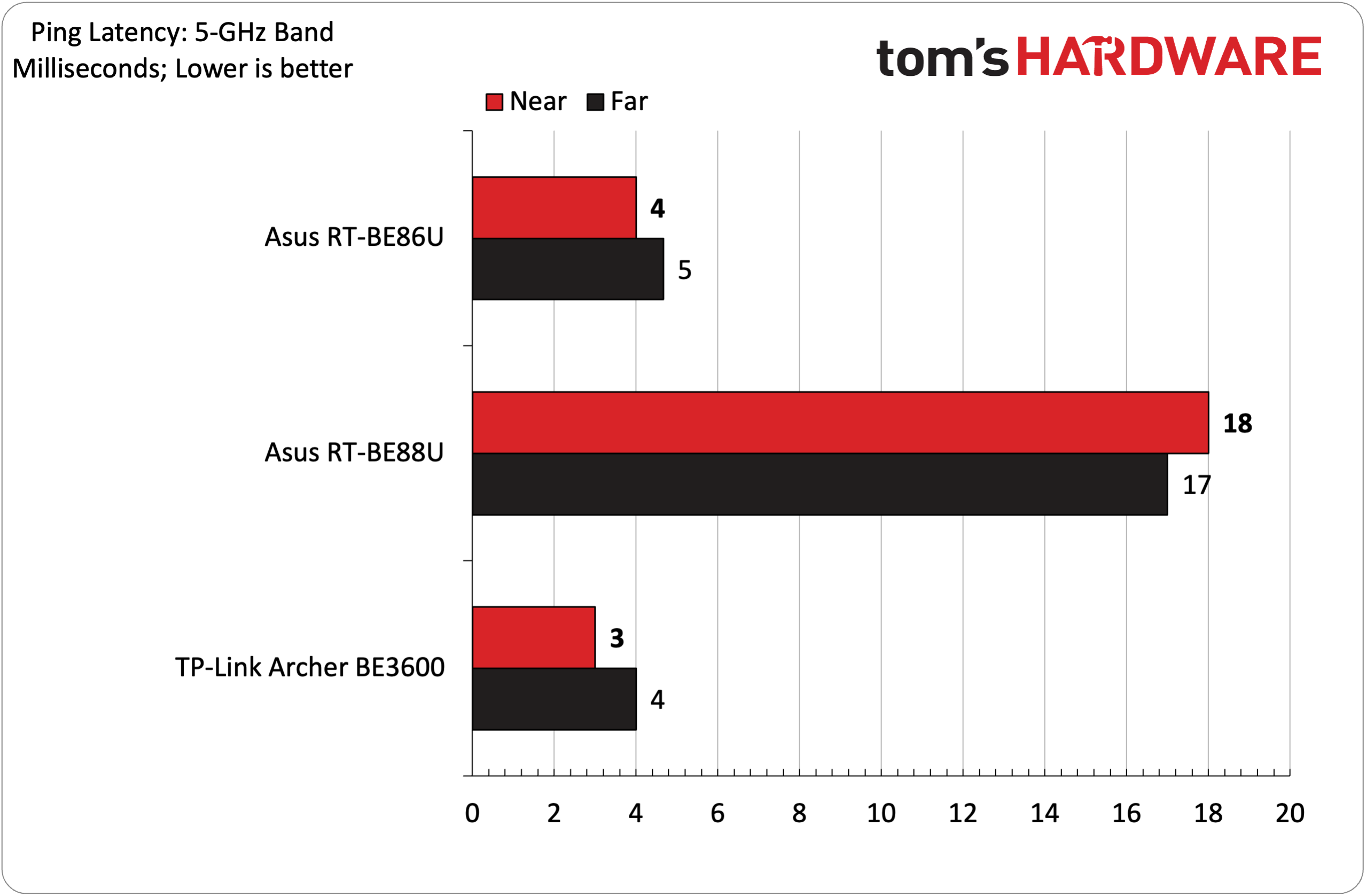Tom's Hardware Verdict
With a $329 price tag, the RT-BE86U is a tough sell in the competitive Wi-Fi 7 router market.
Pros
- +
10 Gbps for WAN, four 2.5 Gbps ports for LAN
- +
Class-leading 5 GHz performance
- +
Amazing assortment of software features
- +
Dual WAN and smartphone tethering support
Cons
- -
Three times the price of competitive dual-band Wi-Fi 7 routers
- -
Lags in 2.4 GHz performance
Why you can trust Tom's Hardware
What makes a Wi-Fi 7 router? Most would say a router that supports the 2.4 GHz, 5 GHz, and 6 GHz bands, and supports channels up to 320 MHz in width. Wi-Fi 7 also supports Multi-Link Operation (MLO), allowing a client to combine multiple bands into a single connection from the router.
The first Wi-Fi 7 routers to hit the market came with a significant price premium over their Wi-Fi 6 and Wi-Fi 6E counterparts. To counter this price disparity, router manufacturers have introduced cheaper models that lack the 6 GHz band. Dropping the 6 GHz eliminates some of the performance advantages of Wi-Fi 7, including the 320 MHz channel width. However, this market trend allows Wi-Fi 7 routers to be offered for as low as $99.
Asus has already launched a dual-band Wi-Fi 7 router we reviewed earlier this year, the RT-BE88U. We now have the RT-BE86U, which has a slightly lower price point and is geared more toward gamers. However, with a street price of $329, the RT-BE86U has much to prove to be counted among the best Wi-Fi routers.
Design of the Netgear Nighthawk RS600 Wi-Fi 7 Router
The RT-BE86U has a modern design that sits upright, rather than the more traditional design of the RT-BE88U. Three poseable antennas sprout from the top of the router. The front of the router features diagonal ventilation slots at the top and lower vents trimmed in red. The Asus logo is positioned vertically at the center of the body, while the status LEDs are lined up in a row beneath. From left to right are LEDs for internet status, the four 2.5 GbE LAN ports, the 10 GbE WAN port, USB, 2.4 GHz band, 5 GHz band, and power.







There are more ventilation slots on the back of the router with a stylized “WIFI 7” running diagonally. From right to left, you’ll find the reset button, power port, power switch, four 2.5 GbE LAN ports, a 10 GbE LAN port, a USB 3.0 port, and a USB 2.0 port. There’s an LED on/off switch on the right side of the router, while the WPS button is on the left.
Asus RT-BE86U Wi-Fi 7 Router Specifications
| Wi-Fi Standard | Wi-Fi 7 |
| Wi-Fi Bands | 2.4-GHz: 3x3 (Tx/Rx), up to 1,032 Mbps |
| 5-GHz: 4x4 (Tx/Rx), up to 5,764 Mbps | |
| CPU | 2.6 GHz quad-core processor |
| Memory | 1GB RAM and 256 MB Flash |
| Ports | 1 x 10Gbps for WAN/LAN, 1 x 2.5 Gbps for WAN/LAN, 3 x 2.5Gbps for LAN, USB 3.2 Gen1 x1, USB 2.0 Gen 1 x1 |
| Wi-Fi Coverage | 2,750 square feet |
Setting up the Asus RT-BE86U Wi-Fi 7 Router
Like many routers today, the initial setup of the RT-BE86U can be accomplished using the traditional web interface or an app. I opted for the app since it is easy to navigate and use. The Asus Router app is available for Android and iOS and first requires you to select the product family to which your router belongs. Next, you must scan the QR code on the bottom of the router with your smartphone’s camera. The setup program then asks to connect to the router via Wi-Fi and continues with the setup process.
You’ll be asked to choose if you want to combine the 2.4 GHz and 5 GHz bands under one SSID or choose separate SSIDs for each band (I chose the latter). The setup program then automatically added an SSID called Asus_IOT to isolate your IoT devices (i.e., security cameras, thermostats, smart speakers, etc.). Finally, the setup program recommended that I update the firmware on the RT-BE86U since it was out of date at the time of setup.
Get Tom's Hardware's best news and in-depth reviews, straight to your inbox.
If you prefer, you can use a web browser router to complete setup. The setup process is much the same by going this route, minus the requirement to use your smartphone camera to scan a QR code.
When I completed the setup via the app, the entire process took about five minutes from start to finish. When I reset the router and went through the process using a web browser, it took about two minutes since I didn’t need to perform another firmware update.
Asus RT-BE86U Wi-Fi 7 Router Software
Not surprisingly, the RT-BE86U runs the AsusWRT 5.0 firmware. Our review unit (after it completed the initial firmware update) is running version 3.0.0.6.102_37022. To say that AsusWRT 5.0 is feature-packed when it comes to software is an understatement. For example, the RT-BE86U supports Dual WAN, allowing you to have a backup ISP connected to one of the two WAN ports in case your primary connection is offline. If that wasn’t enough, a 4G/5G tether option is possible via one of the USB ports. With this option, you can connect your smartphone to the RT-BE86U using a USB cable and piggyback off your phone’s cellular internet connection.
Other niceties include Adaptive QoS, AiMesh (for combining multiple supported routers into a mesh network), a traffic analyzer, comprehensive parental controls (including enabling settings on a schedule), and AI Protection (malicious site blocker, protection from DDoS attacks, and quarantine protocols for infected devices).




There’s also integrated support for OpenNAT, which can configure port forwarding rules for many popular games, ensuring you have the best online gaming experience. Other gaming-centric software features include Gear Accelerator, which prioritizes specific devices on your network and optimizes mobile gaming via the Asus Router app.
AI Cloud 2.0 lets you access your USB-attached storage devices from anywhere in the world, and there’s also Amazon Alexa support for tight integration with your smart home network. Finally, Apple Time Machine backups are supported via the USB ports on the back of the router if you’re a Mac user.
In addition to all the useful software features, there are many configuration options to dial in your network to your exact specifications.
Asus RT-BE86U Wi-Fi 7 Router Performance
As usual, our Wi-Fi router testbed features a Windows 11 desktop with an MSI Pro B650M-A Wi-Fi motherboard, AMD Ryzen 5 7600, 32GB of DDR5, a 1TB PCIe 4.0 SSD, and an MSI Herald-BE Wi-Fi 7 PCIe adapter. This is a small form factor (SFF) PC that I can carry from room to room with ease for distance testing.
The iPerf3 throughput tests are run using our Windows 11 server with an onboard 10 Gbps wired network card connected to the 10 Gbps LAN port on the RT-BE86U. Wireless tests were conducted at 6-foot and 25-foot distances.
All wireless tests are initially run when the network is free of additional traffic from other connected clients. Tests are then performed to simulate traffic from additional users accessing the network (for our testing, we use six clients streaming 4K video from YouTube).








The RT-BE86U kicked off the iPerf tests with a strong showing against the competition with uncongested traffic. On the 5 GHz band, the router hit 1,473 Mbps at 6 feet and 806 Mbps at 25 feet. It only gave ground to the RT-BE88U at 25 feet, where it was roughly 150 Mbps slower. However, the RT-BE86U's performance was well ahead of the TP-Link Archer BE3600, especially at 25 feet, where it was more than twice as fast.
Switching to our congested testing profile, the RT-BE86U barely missed a beat at 6 feet (1,390 Mbps) but suffered greatly at 25 feet (431 Mbps). This was a 47 percent reduction in performance compared to testing at 6 feet. Still, both results put the RT-BE86U ahead of its RT-BE88U sibling and the Archer BE3600.
When looking at 2.4 GHz congested iPerf performance, the tables turned dramatically. The Archer BE3600 nearly doubled the performance of the RT-BE86U at 6 feet, although this advantage was nearly eliminated at 25 feet. With congested traffic, the Archer BE3600 again opened a 2x lead over the RT-BE86U at six feet, with a smaller lead at 25 feet.
In all our tests, ping times were 7ms or lower — this was the case in uncongested and congested traffic at 6-foot and 25-foot distances.
Bottom Line
The Asus RT-BE86U is an enigma in the wireless router market. It’s a dual-band router that can’t come close to approaching the maximum performance potential of tri-band routers that comply with all Wi-Fi 7 specifications. Given that it doesn’t come to the market with a complete Wi-Fi feature set, you would expect bargain pricing to match, but that isn’t the case. The RT-BE86U has a street price of $329, making it over three times the dual-band TP-Link Archer BE3600’s price, which retails for $99. The Archer BE3600 misses out on a 10 Gbps WAN port, but it does offer two 2.5 Gbps ports.
Regarding performance, the RT-BE86U shines at 5 GHz, offering significant performance gains over the Archer BE3600, especially at 25-foot distances. However, the Archer BE3600 flips the script and dominates with short-range performance on the 2.4 GHz band.
The RT-BE86U also has a kitchen sink full of software features that make for a compelling option for some consumers. For example, it offers Dual WAN connectivity and smartphone fallback. It also has vital gaming optimizations, comprehensive parental controls, and networking monitoring at no extra cost. Even Mac users get a shout-out with Time Machine support.
However, it remains to be seen if those added features are enough for consumers on a budget to opt for an RT-BE86U over a $99 Archer BE3600. Dual-band Wi-Fi 7 routers are supposed to be aimed at the value end of the market, but at $329, the RT-BE86 is a hard sell. After all, you can get a tri-band TP-Link Archer BE800 for $391, which would be a far better option to futureproof your home network.

Brandon Hill is a senior editor at Tom's Hardware. He has written about PC and Mac tech since the late 1990s with bylines at AnandTech, DailyTech, and Hot Hardware. When he is not consuming copious amounts of tech news, he can be found enjoying the NC mountains or the beach with his wife and two sons.
-
das_stig Just a AX86U clone with a couple new components, same milking of the consumer.Reply
Remember when Asus use to innovate and not just copy-n-paste.
